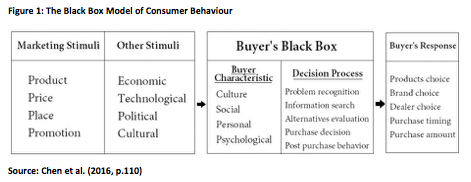Written by Josh A.
1. Introduction
Due to their growing popularity with consumers, social media have become an effective marketing communications channel as well as one-to-one communication means (Keegan and Rowley, 2017). Social media marketing (SMM) is commonly reported to contribute to consumer engagement and create positive perceptions and attitudes towards brands, products, and services (Chen et al., 2016). While SMM influences the way consumers evaluate and perceive goods and services in the online environment, it does not necessarily results in a purchase decision (Barger et al., 2016). The main aim of this essay is to examine the effect of social media marketing on consumer behaviour and product performance relying on the most relevant scholarly and empirical literature (Duffett, 2017; Funk, 2014). The essay is organised into four sections, namely introduction, consumer behaviour theory, the impact of SMM on consumer behaviour and product performance, and conclusion.
2. Consumer Behaviour Theory
The black box model is one of the most widely used theories, which explains the various elements of the marketing process in general and how consumers respond to external marketing stimuli in particular (Varkaris and Neuhofer, 2017).
The black box model implies that consumer behaviour has three major dimensions, namely external stimuli, individual characteristics, and consumer response. In accordance with Funk (2014), organisations can impact consumer behaviour through the use of various marketing stimuli, including product, price, place, and promotion. In turn, Keegan and Rowley (2017) added that such dimensions of the marketing mix as people, physical evidence, and process also influence consumer behaviour. The role of economic, technological, political, environmental, and cultural factors in consumer behaviour is widely acknowledged in the existing marketing literature (Valos et al., 2016). While marketers are able to control the elements of the marketing mix, they cannot have any significant impact on personal and psychological characteristics (Keegan and Rowley, 2017). Nonetheless, these additional stimuli must be taken into account to achieve the desired response from consumers.
The emergence and growing popularity of information technology has significantly influenced to the consumer decision-making process (Chen et al., 2016). SMM helps consumers search for product-related information in a much faster and convenient manner as compared to more traditional communications channels (Duffett, 2017). However, increased access to information has made it more difficult for marketers to stimulate consumers’ purchase behaviour and make them respond to marketing stimuli in a particular manner. For example, during the alternate evaluation process, consumers can rely on other consumers’ opinions, perceptions, and attitudes when making their own decision to buy (Patel, 2017). This situation poses a certain threat to companies’ ability to sell their goods as their marketing message is totally controlled by social media users. As noted by Rishi and Bandyopadhyay (2017), negative word of mouth is one of the main reasons why consumers tend to avoid purchasing certain goods and services online. In turn, the lack of access to this information in the offline environment provides marketers with greater power to influence consumers’ mind (Keegan and Rowley, 2017).
Organisations operating online tend to use SMM to more effectively engage with consumers and make their products and services more attractive (Rishi and Bandyopadhyay, 2017). In accordance with Barger et al. (2016), social media is a powerful platform that allows for establishing two-way communication between the company and the consumer at low costs. By using social media, enterprises can establish a dialogue with consumers, which is very difficult by using traditional marketing instruments (e.g. printed materials). In turn, more effective and quicker communication results in higher levels of consumer satisfaction (Russo and Simeone, 2017). However, Dolan et al. (2017) argued that consumers’ satisfaction depended on the extent to which the information provided by the company was perceived by them as valuable and useful. This statement is in keeping with the black box model of consumer behaviour, which implies that individual characteristics can moderate the effectiveness of firms’ marketing efforts, including those taken in the online environment (Chen et al., 2016).
Although the black box model is actively used by marketers who operate both online and offline, this theoretical framework is not free from limitations and drawbacks. One of its main limitations refers to the inconsistency between the black box and the actual behaviour of consumers (Keegan and Rowley, 2017). The point is that consumers rarely apply the same steps in the same sequence for every good or service they buy in the online environment. This fact makes it difficult for companies to stimulate a certain want or to communicate the message that would encourage certain behaviour using SMM (Patel, 2017). Another issue with the black box model is the limited extent to which consumers are involved in the decision-making process. This statement is especially relevant to fast-moving consumer goods, which are usually bought without going through a complex analysis process (Valos et al., 2016). As a result, the limited involvement in the purchase decision results in spending less time on searching for relevant information and evaluating alternatives.
3. The Impact of SMM on Consumer Behaviour and Product Performance
In general, empirical research on the role of SMM in consumer behaviour and product performance is limited. Nonetheless, prior empirical works make a contribution towards supporting the positive effect of SMM efforts on consumer outcomes. For example, Stelzner (2014) surveyed 5,700 marketers across different industries and several countries on the topic of SMM. The researcher revealed that the significant majority of respondents reported that the use of SMM practices increased exposure (88% of respondents) and traffic (78% of respondents) (Stelzner, 2014). Another insight of the study was that even though consumers retained their preferences and willingness to pay for a product, regardless of whether they had seen a physical or a digital advertisement, they saw a greater value in a physical medium (Stelzner, 2014). The positive effects of SMM on product performance are in line with other researchers, namely Agnihotri et al. (2016) and Cui and Wu (2016). The results of the survey should be generalised with caution, as the respondents were predominantly from the UK and the US.
In 2015, the United States Postal Service conducted an extensive study on consumer behaviour in the context of printed and digital media, using the latest advancements in neuroscience (OIG, 2015). This study is of interest because digital media represent SMM and printed media refers to traditional marketing. In contrast to the previous findings, the study concluded that printed media had a greater positive impact on respondents than digital media (OIG, 2015).
Agnihotri et al. (2016) examined the positive effect of social media marketing use on B2B sales. The researchers concluded that the use of SMM positively affected communication and information transfer, which improved management responsiveness. In addition, the study suggested that SMM added to customer satisfaction, while the degree of usefulness of the information transferred to consumers moderates this link (Agnihotri et al., 2016). This is a contrast to the previously mentioned findings, which argued that a firm’s engagement in SMM led to better product performance (Cui and Wu, 2016; Stelzner, 2014). According to Agnihotri et al. (2016), if the information transferred in SMM is of no use to customers, then there would not be any improvement in customer satisfaction. The main limitation of this study is that all the measures were self-reported. Each respondent had to evaluate their own satisfaction with their service, which is subject to bias. Nonetheless, in their seminal paper, Bitner et al. (1994) argued that in general, employees were good sources of information on customer behaviour.
Ashley and Tuten (2015) used content analysis to examine the creative strategies of a sample of top brands in regards to SMM. The empirical findings reinforce conclusions from previously mentioned scholars (e.g. Agnihotri et al., 2016; Cui and Wu, 2016; Stelzner, 2014), arguing for the importance of customers’ incentives to participate and linking it to the product performance. Moreover, Ashley and Tuten (2015) identified several marketing strategies, which positively influenced customer engagement (i.e. image, experiential, and exclusivity messages). However, the study was based on two lists, neglecting thousands of companies, within a very limited period of time due to the enormous amount of SMM content and data being released and generated every day. Although it offers interesting insights, Ashley and Tuten’s (2015) project has a limited scope for generalisation and practical implementation.
4. Conclusion
SMM is an effective marketing instrument that helps companies effectively communicate their brand message to potential customers and clients. The analysis of the existing empirical literature has demonstrated that the use of SMM results in more effective two-way communication (Patel, 2017). It is also positively associated with such consumer outcomes as higher levels of motivation, engagement, and loyalty (Dolan et al., 2017). While there is some evidence that SMM positively affects sales in the online environment, the body of literature on this matter is scarce and fragmented (Rishi and Bandyopadhyay, 2017; Cui and Wu, 2016). The poor predictability of consumer behaviour is an important issue that limits the effectiveness of SMM in relation to product performance (Funk, 2014).
References
Agnihotri, R., Dingus, R., Hu, M. and Krush, M. (2016) “Social media: Influencing customer satisfaction in B2B sales”, Industrial Marketing Management, 53 (1), pp. 172-180.
Ashley, C. and Tuten, T. (2015) “Creative strategies in social media marketing: An exploratory study of branded social content and consumer engagement”, Psychology & Marketing, 32 (1), pp. 15-27.
Barger, V., Peltier, J. and Schultz, D. (2016) “Social media and consumer engagement: A review and research agenda”, Journal of Research in Interactive Marketing, 10 (4), pp. 268-287.
Bitner, M., Booms, B. and Mohr, L. (1994) “Critical service encounters: The employee’s viewpoint”, The Journal of Marketing, 58 (4), pp. 95-106.
Chen, Y., Tso-Jen, C. and Lin, C. (2016) “The analyses of purchasing decisions and brand loyalty for Smartphone consumers”, Open Journal of Social Sciences, 4 (7), pp. 108-116.
Cui, A. and Wu, F. (2016) “Utilizing customer knowledge in innovation: Antecedents and impact of customer involvement on new product performance”, Journal of the Academy of Marketing Science, 44 (4), pp. 516-538.
Dolan, R., Conduit, J., Fahy, J. and Goodman, S. (2017) “Social media: Communication strategies, engagement and future research directions”, International Journal of Wine Business Research, 29 (1), pp. 2-19.
Duffett, R. (2017) “Influence of social media marketing communications on young consumers’ attitudes”, Young Consumers, 18 (1), pp. 19-39.
Funk, T. (2014) Advanced social media marketing: How to lead, launch, and manage a successful social media program, New York: Apress.
Keegan, B. and Rowley, J. (2017) “Evaluation and decision making in social media marketing”, Management Decision, 55 (1), pp. 15-31.
OIG (2015) “Enhancing the Value of Mail: The Human Response”, [online] Available at: https://www.uspsoig.gov/sites/default/files/document-library-files/2015/rarc-wp-15-012.pdf [Accessed 8 December 2018].
Patel, D. (2017) Social media marketing fundamentals, Mumbai: VDS Developers.
Rishi, B. and Bandyopadhyay, S. (2017) Contemporary issues in social media marketing, New Delhi: Routledge.
Russo, C. and Simeone, M. (2017) “The growing influence of social and digital media: Impact on consumer choice and market equilibrium”, British Food Journal, 119 (8), pp. 1766-1780.
Stelzner, M. (2014) “Social Media Marketing Industry Report”, [online] Available at: https://www.socialmediaexaminer.com/social-media-marketing-industry-report-2018/ [Accessed on 8 December 2018].
Valos, M., Haji Habibi, F., Casidy, R., Driesener, C. and Maplestone, V. (2016) “Exploring the integration of social media within integrated marketing communication frameworks: Perspectives of services marketers”, Marketing Intelligence & Planning, 34 (1), pp. 19-40.
Varkaris, E. and Neuhofer, B. (2017) “The influence of social media on the consumers’ hotel decision journey”, Journal of Hospitality and Tourism Technology, 8 (1), pp. 101-118.


